Deck 35: Stem Structure and Transport
Question
Question
Question
Question
Question
Question
Question
Question
Question
Question
Question
Question
Question
Question
Question
Question
Question
Question
Question
Question
Question
Question
Question
Question
Question
Question
Question
Question
Question
Question
Question
Question
Question
Question
Question
Question
Question
Question
Question
Question
Question
Question
Question
Question
Question
Question
Question
Question
Question
Question
Question
Question
Question
Question
Question
Question
Question
Question
Question
Question
Question
Question
Match between columns
Question
Question
Match between columns
Question
Question
Match between columns
Question
Question
Question
Question
Question
Question
Question
Question
Question

Unlock Deck
Sign up to unlock the cards in this deck!
Unlock Deck
Unlock Deck
1/75
Play
Full screen (f)
Deck 35: Stem Structure and Transport
1
Which of the following is a function of stems?
A) sexually reproduce
B) absorb nutrient minerals
C) produce new tissues
D) transport dissolved gases
E) anchor plants
A) sexually reproduce
B) absorb nutrient minerals
C) produce new tissues
D) transport dissolved gases
E) anchor plants
C
2
Unlike herbaceous eudicot stems, monocot stems do not have distinct areas of cortex and pith. Instead, their ____ functions as the cortex and pith.
A) endodermis
B) ground tissue
C) meristem
D) vascular cambium
E) periderm
A) endodermis
B) ground tissue
C) meristem
D) vascular cambium
E) periderm
B
3
____ join roots to leaves and may be above or underground.
A) Vines
B) Stems
C) Petioles
D) Flowers
E) Runners
A) Vines
B) Stems
C) Petioles
D) Flowers
E) Runners
B
4
Figure 35-1 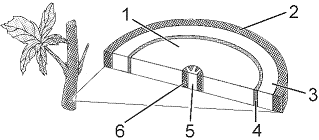 In the accompanying figure, the function of the structure labeled as 1 represents:
In the accompanying figure, the function of the structure labeled as 1 represents:
A) the formation of pith.
B) protection.
C) conduction of water and dissolved minerals from the roots.
D) conduction of sugars from the leaves.
E) photosynthesis.
 In the accompanying figure, the function of the structure labeled as 1 represents:
In the accompanying figure, the function of the structure labeled as 1 represents:A) the formation of pith.
B) protection.
C) conduction of water and dissolved minerals from the roots.
D) conduction of sugars from the leaves.
E) photosynthesis.

Unlock Deck
Unlock for access to all 75 flashcards in this deck.
Unlock Deck
k this deck
5
Figure 35-1 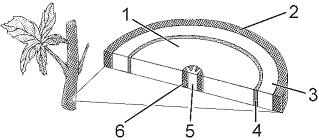 In the accompanying figure, the structure labeled as 3 is:
In the accompanying figure, the structure labeled as 3 is:
A) the secondary xylem.
B) formed by the division of the vascular cambium.
C) found adjacent to the pith.
D) usually referred to as wood.
E) the cork cambium.
 In the accompanying figure, the structure labeled as 3 is:
In the accompanying figure, the structure labeled as 3 is:A) the secondary xylem.
B) formed by the division of the vascular cambium.
C) found adjacent to the pith.
D) usually referred to as wood.
E) the cork cambium.

Unlock Deck
Unlock for access to all 75 flashcards in this deck.
Unlock Deck
k this deck
6
Which of the following statements about the cortex is true?
A) It secretes a protective layer of cutin.
B) It is at the core of the herbaceous eudicot stem.
C) It is filled with cork cells.
D) It translocates sugar by means of a pressure gradient.
E) It may contain collenchyma and sclerenchyma.
A) It secretes a protective layer of cutin.
B) It is at the core of the herbaceous eudicot stem.
C) It is filled with cork cells.
D) It translocates sugar by means of a pressure gradient.
E) It may contain collenchyma and sclerenchyma.

Unlock Deck
Unlock for access to all 75 flashcards in this deck.
Unlock Deck
k this deck
7
Dissolved sugars are transported in:
A) cork cambium.
B) epidermis.
C) pith.
D) phloem.
E) xylem.
A) cork cambium.
B) epidermis.
C) pith.
D) phloem.
E) xylem.

Unlock Deck
Unlock for access to all 75 flashcards in this deck.
Unlock Deck
k this deck
8
Secondary growth occurs as a result of the activity of which two lateral meristems?
A) vascular cambium and cork cambium
B) apical meristem and cork cambium
C) primary meristem and secondary meristem
D) periderm and cork cambium
E) apical meristem and vascular cambium
A) vascular cambium and cork cambium
B) apical meristem and cork cambium
C) primary meristem and secondary meristem
D) periderm and cork cambium
E) apical meristem and vascular cambium

Unlock Deck
Unlock for access to all 75 flashcards in this deck.
Unlock Deck
k this deck
9
____ is the functional replacement for the epidermis.
A) Xylem
B) Periderm
C) Pith
D) Cortex
E) Cork
A) Xylem
B) Periderm
C) Pith
D) Cortex
E) Cork

Unlock Deck
Unlock for access to all 75 flashcards in this deck.
Unlock Deck
k this deck
10
Monocots such as palms and bamboo achieve considerable increase in girth by:
A) a modified form of secondary growth in which parenchyma cells divide and enlarge.
B) primary growth.
C) a modified form of primary growth in which parenchyma cells divide and enlarge.
D) enlargement of primary xylem.
E) enlargement of primary phloem.
A) a modified form of secondary growth in which parenchyma cells divide and enlarge.
B) primary growth.
C) a modified form of primary growth in which parenchyma cells divide and enlarge.
D) enlargement of primary xylem.
E) enlargement of primary phloem.

Unlock Deck
Unlock for access to all 75 flashcards in this deck.
Unlock Deck
k this deck
11
Which of the following statements about monocots is true?
A) They lack sclerenchyma tissue.
B) They have a well-developed vascular cambium.
C) They do not produce bark.
D) Their lateral meristems give rise to wood.
E) Secondary growth occurs rather slowly.
A) They lack sclerenchyma tissue.
B) They have a well-developed vascular cambium.
C) They do not produce bark.
D) Their lateral meristems give rise to wood.
E) Secondary growth occurs rather slowly.

Unlock Deck
Unlock for access to all 75 flashcards in this deck.
Unlock Deck
k this deck
12
One function of cortical parenchyma cells is:
A) photosynthesis.
B) to provide structural support and strength.
C) to produce cutin.
D) to conduct water and nutrient minerals.
E) to conduct sugars.
A) photosynthesis.
B) to provide structural support and strength.
C) to produce cutin.
D) to conduct water and nutrient minerals.
E) to conduct sugars.

Unlock Deck
Unlock for access to all 75 flashcards in this deck.
Unlock Deck
k this deck
13
At the center of an herbaceous eudicot stem is:
A) pith.
B) collenchyma.
C) sclerenchyma.
D) vascular cambium.
E) phloem.
A) pith.
B) collenchyma.
C) sclerenchyma.
D) vascular cambium.
E) phloem.

Unlock Deck
Unlock for access to all 75 flashcards in this deck.
Unlock Deck
k this deck
14
Periderm is produced by:
A) xylem.
B) cork cambium.
C) pith.
D) cortex.
E) phloem.
A) xylem.
B) cork cambium.
C) pith.
D) cortex.
E) phloem.

Unlock Deck
Unlock for access to all 75 flashcards in this deck.
Unlock Deck
k this deck
15
Vascular cambium gives rise to which of the following tissues?
A) primary phloem
B) periderm
C) epidermis
D) secondary xylem
E) cork cambium
A) primary phloem
B) periderm
C) epidermis
D) secondary xylem
E) cork cambium

Unlock Deck
Unlock for access to all 75 flashcards in this deck.
Unlock Deck
k this deck
16
Cork cambium and the tissues it produces are collectively known as:
A) periderm.
B) epidermis.
C) xylem.
D) pith.
E) cortex.
A) periderm.
B) epidermis.
C) xylem.
D) pith.
E) cortex.

Unlock Deck
Unlock for access to all 75 flashcards in this deck.
Unlock Deck
k this deck
17
Cells produced on the inside of the vascular cambium differentiate to form which vascular tissue?
A) cork cambium
B) primary phloem
C) primary xylem
D) secondary phloem
E) secondary xylem
A) cork cambium
B) primary phloem
C) primary xylem
D) secondary phloem
E) secondary xylem

Unlock Deck
Unlock for access to all 75 flashcards in this deck.
Unlock Deck
k this deck
18
Figure 35-1 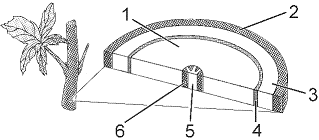 In the accompanying figure, the structure labeled as 2 is:
In the accompanying figure, the structure labeled as 2 is:
A) known as wood.
B) produced by cork cambium (not shown).
C) composed largely of secondary tissue.
D) composed largely of cells that are alive at maturity.
E) commonly called scales.
 In the accompanying figure, the structure labeled as 2 is:
In the accompanying figure, the structure labeled as 2 is:A) known as wood.
B) produced by cork cambium (not shown).
C) composed largely of secondary tissue.
D) composed largely of cells that are alive at maturity.
E) commonly called scales.

Unlock Deck
Unlock for access to all 75 flashcards in this deck.
Unlock Deck
k this deck
19
The outermost cell layer of herbaceous stems is the:
A) bark.
B) cortex.
C) endodermis.
D) epidermis.
E) periderm.
A) bark.
B) cortex.
C) endodermis.
D) epidermis.
E) periderm.

Unlock Deck
Unlock for access to all 75 flashcards in this deck.
Unlock Deck
k this deck
20
The thin layer of meristematic cells located between xylem and phloem is referred to as the:
A) apical meristem.
B) collenchyma.
C) cork cambium.
D) vascular cambium.
E) pith.
A) apical meristem.
B) collenchyma.
C) cork cambium.
D) vascular cambium.
E) pith.

Unlock Deck
Unlock for access to all 75 flashcards in this deck.
Unlock Deck
k this deck
21
Which of the following statements about heartwood is false ?
A) It functions in conduction.
B) It is a storage site for waste products.
C) It is resistant to decay.
D) It provides structural support.
E) It is located in the center of a tree.
A) It functions in conduction.
B) It is a storage site for waste products.
C) It is resistant to decay.
D) It provides structural support.
E) It is located in the center of a tree.

Unlock Deck
Unlock for access to all 75 flashcards in this deck.
Unlock Deck
k this deck
22
Figure 35-2 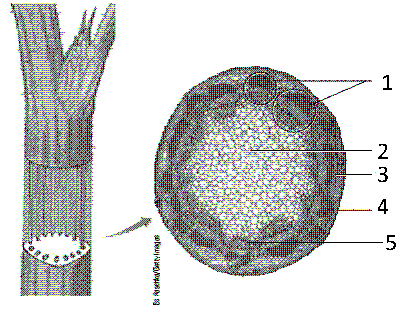 In the accompanying figure, the structure responsible for photosynthesis, storage, and support is labeled as:
In the accompanying figure, the structure responsible for photosynthesis, storage, and support is labeled as:
A) 1
B) 2
C) 3
D) 4
E) 5
 In the accompanying figure, the structure responsible for photosynthesis, storage, and support is labeled as:
In the accompanying figure, the structure responsible for photosynthesis, storage, and support is labeled as:A) 1
B) 2
C) 3
D) 4
E) 5

Unlock Deck
Unlock for access to all 75 flashcards in this deck.
Unlock Deck
k this deck
23
Figure 35-3  In the accompanying figure, the structure labeled as ____ is formed in the leaf scars by vascular tissue that extends from the stem out into the leaf.
In the accompanying figure, the structure labeled as ____ is formed in the leaf scars by vascular tissue that extends from the stem out into the leaf.
A) 5
B) 6
C) 7
D) 8
E) 9
 In the accompanying figure, the structure labeled as ____ is formed in the leaf scars by vascular tissue that extends from the stem out into the leaf.
In the accompanying figure, the structure labeled as ____ is formed in the leaf scars by vascular tissue that extends from the stem out into the leaf.A) 5
B) 6
C) 7
D) 8
E) 9

Unlock Deck
Unlock for access to all 75 flashcards in this deck.
Unlock Deck
k this deck
24
In woody plants, the lateral transport of materials occurs through:
A) lenticels.
B) pith.
C) pith rays.
D) phloem fiber caps.
E) rays.
A) lenticels.
B) pith.
C) pith rays.
D) phloem fiber caps.
E) rays.

Unlock Deck
Unlock for access to all 75 flashcards in this deck.
Unlock Deck
k this deck
25
Functional secondary xylem that conducts water and dissolved minerals is known as:
A) softwood.
B) springwood.
C) hardwood.
D) sapwood.
E) heartwood.
A) softwood.
B) springwood.
C) hardwood.
D) sapwood.
E) heartwood.

Unlock Deck
Unlock for access to all 75 flashcards in this deck.
Unlock Deck
k this deck
26
____ is denser than ____.
A) Heartwood; sapwood
B) Heartwood; softwood
C) Sapwood; hardwood
D) Sapwood; heartwood
E) Softwood; hardwood
A) Heartwood; sapwood
B) Heartwood; softwood
C) Sapwood; hardwood
D) Sapwood; heartwood
E) Softwood; hardwood

Unlock Deck
Unlock for access to all 75 flashcards in this deck.
Unlock Deck
k this deck
27
Figure 35-2 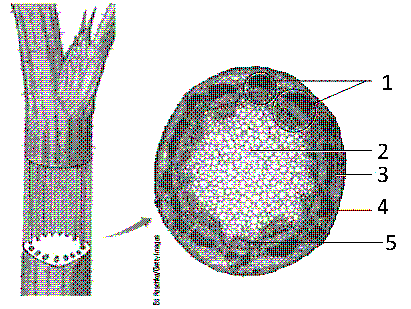 In the accompanying figure, the cell layer that contains xylem is labeled as:
In the accompanying figure, the cell layer that contains xylem is labeled as:
A) 1
B) 2
C) 3
D) 4
E) 5
 In the accompanying figure, the cell layer that contains xylem is labeled as:
In the accompanying figure, the cell layer that contains xylem is labeled as:A) 1
B) 2
C) 3
D) 4
E) 5

Unlock Deck
Unlock for access to all 75 flashcards in this deck.
Unlock Deck
k this deck
28
Softwood is the wood:
A) found at the center of a tree.
B) of cone-bearing gymnosperms.
C) of flowering plants.
D) formed when water is abundant.
E) formed when water is less abundant.
A) found at the center of a tree.
B) of cone-bearing gymnosperms.
C) of flowering plants.
D) formed when water is abundant.
E) formed when water is less abundant.

Unlock Deck
Unlock for access to all 75 flashcards in this deck.
Unlock Deck
k this deck
29
Secondary xylem contains all of the following cell types except :
A) tracheids.
B) vessel elements.
C) sieve tube elements
D) fibers.
E) parenchyma.
A) tracheids.
B) vessel elements.
C) sieve tube elements
D) fibers.
E) parenchyma.

Unlock Deck
Unlock for access to all 75 flashcards in this deck.
Unlock Deck
k this deck
30
Figure 35-3  What is the age of the twig in the accompanying figure?
What is the age of the twig in the accompanying figure?
A) 0 years
B) 1 year
C) 2 years
D) 3 years
E) 5 years
 What is the age of the twig in the accompanying figure?
What is the age of the twig in the accompanying figure?A) 0 years
B) 1 year
C) 2 years
D) 3 years
E) 5 years

Unlock Deck
Unlock for access to all 75 flashcards in this deck.
Unlock Deck
k this deck
31
____ is the wood of flowering plants and ____ is the wood of conifers.
A) Hardwood; softwood
B) Summer wood; spring wood
C) Softwood; hardwood
D) Spring wood; summer wood
E) Heartwood; softwood
A) Hardwood; softwood
B) Summer wood; spring wood
C) Softwood; hardwood
D) Spring wood; summer wood
E) Heartwood; softwood

Unlock Deck
Unlock for access to all 75 flashcards in this deck.
Unlock Deck
k this deck
32
Concentric rings found in the cross section of the wood of trees are known as:
A) summer rings.
B) spring rings.
C) annual rings.
D) dendrochrons.
E) pith rings.
A) summer rings.
B) spring rings.
C) annual rings.
D) dendrochrons.
E) pith rings.

Unlock Deck
Unlock for access to all 75 flashcards in this deck.
Unlock Deck
k this deck
33
Although the same cell types can be found in both primary and secondary phloem, ____ are usually more abundant in secondary phloem.
A) parenchyma
B) fibers
C) vessel elements
D) companion cells
E) sieve tube members
A) parenchyma
B) fibers
C) vessel elements
D) companion cells
E) sieve tube members

Unlock Deck
Unlock for access to all 75 flashcards in this deck.
Unlock Deck
k this deck
34
____ is when liquid water is forced out of the surface of leaves.
A) Root pressure
B) Transpiration
C) Guttation
D) Hydration
E) Translocation
A) Root pressure
B) Transpiration
C) Guttation
D) Hydration
E) Translocation

Unlock Deck
Unlock for access to all 75 flashcards in this deck.
Unlock Deck
k this deck
35
Embryonic shoots located at the tips of stems are called ____, while those located in the axils are known as ____.
A) nodes; internodes
B) axillary buds; terminal buds
C) terminal buds; axillary buds
D) axillary buds; lateral buds
E) bud scales; bud scale scars
A) nodes; internodes
B) axillary buds; terminal buds
C) terminal buds; axillary buds
D) axillary buds; lateral buds
E) bud scales; bud scale scars

Unlock Deck
Unlock for access to all 75 flashcards in this deck.
Unlock Deck
k this deck
36
Dendrochronology can be useful in determining:
A) the dates of past earthquakes and volcanic eruptions.
B) future climate patterns.
C) the solution to global warming.
D) how tree growth affects air pollution.
E) the time of day.
A) the dates of past earthquakes and volcanic eruptions.
B) future climate patterns.
C) the solution to global warming.
D) how tree growth affects air pollution.
E) the time of day.

Unlock Deck
Unlock for access to all 75 flashcards in this deck.
Unlock Deck
k this deck
37
Lenticels function to:
A) protect undeveloped embryonic shoots.
B) permit gas exchange through the periderm.
C) support leaves and flowers.
D) absorb water and dissolved nutrient minerals.
E) anchor a plant in the ground.
A) protect undeveloped embryonic shoots.
B) permit gas exchange through the periderm.
C) support leaves and flowers.
D) absorb water and dissolved nutrient minerals.
E) anchor a plant in the ground.

Unlock Deck
Unlock for access to all 75 flashcards in this deck.
Unlock Deck
k this deck
38
Water moves from a region of ____ water potential to a region of ____water potential.
A) more positive; less positive
B) less positive; more positive
C) less negative; more negative
D) more negative; less negative
E) more negative; zero
A) more positive; less positive
B) less positive; more positive
C) less negative; more negative
D) more negative; less negative
E) more negative; zero

Unlock Deck
Unlock for access to all 75 flashcards in this deck.
Unlock Deck
k this deck
39
Water and dissolved mineral are transported laterally from the secondary ____ to the secondary ____.
A) phloem; xylem
B) epidermis; peridem
C) vascular cambium; cork cambium
D) periderm; epidermis
E) xylem; phloem
A) phloem; xylem
B) epidermis; peridem
C) vascular cambium; cork cambium
D) periderm; epidermis
E) xylem; phloem

Unlock Deck
Unlock for access to all 75 flashcards in this deck.
Unlock Deck
k this deck
40
Sapwood develops from:
A) secondary xylem
B) secondary phloem
C) primary phloem
D) primary xylem
E) cork parenchyma
A) secondary xylem
B) secondary phloem
C) primary phloem
D) primary xylem
E) cork parenchyma

Unlock Deck
Unlock for access to all 75 flashcards in this deck.
Unlock Deck
k this deck
41
The loading of dissolved sugars into the sieve tube elements of phloem is:
A) passive transport.
B) active transport.
C) osmosis.
D) simple diffusion.
E) facilitated diffusion.
A) passive transport.
B) active transport.
C) osmosis.
D) simple diffusion.
E) facilitated diffusion.

Unlock Deck
Unlock for access to all 75 flashcards in this deck.
Unlock Deck
k this deck
42
Identify four external features of a woody twig and briefly explain the function and/or origin of each.

Unlock Deck
Unlock for access to all 75 flashcards in this deck.
Unlock Deck
k this deck
43
According to the pressure-flow model, ____.
A) water moves from an area of positive water potential to an area of negative water potential
B) the evaporative pull of transpiration produces tension at the top of the plant
C) the flow of sugar is driven by a pressure gradient between the source and the sink
D) pressure is created by the movement of water into the roots from the soil
E) the production of sugar pushes it out of the chloroplast and into the xylem
A) water moves from an area of positive water potential to an area of negative water potential
B) the evaporative pull of transpiration produces tension at the top of the plant
C) the flow of sugar is driven by a pressure gradient between the source and the sink
D) pressure is created by the movement of water into the roots from the soil
E) the production of sugar pushes it out of the chloroplast and into the xylem

Unlock Deck
Unlock for access to all 75 flashcards in this deck.
Unlock Deck
k this deck
44
Using severed aphid mouthparts, scientists have verified that in most species the phloem translocates mostly ____, but that ____ may also be translocated.
A) glucose; amino acids
B) glucose; sugar alcohols
C) glucose; cellulose and starch
D) sucrose; raffinose and sorbitol
E) sucrose; glucose
A) glucose; amino acids
B) glucose; sugar alcohols
C) glucose; cellulose and starch
D) sucrose; raffinose and sorbitol
E) sucrose; glucose

Unlock Deck
Unlock for access to all 75 flashcards in this deck.
Unlock Deck
k this deck
45
Guttation results from:
A) water pressure.
B) transpiration pull.
C) osmotic pressure.
D) root pressure.
E) sink-to-source transport.
A) water pressure.
B) transpiration pull.
C) osmotic pressure.
D) root pressure.
E) sink-to-source transport.

Unlock Deck
Unlock for access to all 75 flashcards in this deck.
Unlock Deck
k this deck
46
Periderm is the functional replacement of the bark .

Unlock Deck
Unlock for access to all 75 flashcards in this deck.
Unlock Deck
k this deck
47
Water is capable of rising to the tops of the tallest trees due to the:
A) chemical bonds of water molecules.
B) push of gravity.
C) adhesion of water molecules to each other.
D) push of ground water.
E) pull of transpiration.
A) chemical bonds of water molecules.
B) push of gravity.
C) adhesion of water molecules to each other.
D) push of ground water.
E) pull of transpiration.

Unlock Deck
Unlock for access to all 75 flashcards in this deck.
Unlock Deck
k this deck
48
When cells of the vascular cambium divide, they produce xylem toward the outside.

Unlock Deck
Unlock for access to all 75 flashcards in this deck.
Unlock Deck
k this deck
49
Xylem transports water and dissolved nutrient minerals in which direction?
A) upward
B) downward
C) inward laterally
D) outward laterally
E) both upward and downward
A) upward
B) downward
C) inward laterally
D) outward laterally
E) both upward and downward

Unlock Deck
Unlock for access to all 75 flashcards in this deck.
Unlock Deck
k this deck
50
Sugar is translocated in phloem from a source, or an area of ____, to a sink, or an area of ____.
A) low sugar concentration; high sugar concentration
B) high sugar concentration; low sugar concentration
C) positive water potential; negative water potential
D) negative water potential; positive water potential
E) low pressure; equally low pressure
A) low sugar concentration; high sugar concentration
B) high sugar concentration; low sugar concentration
C) positive water potential; negative water potential
D) negative water potential; positive water potential
E) low pressure; equally low pressure

Unlock Deck
Unlock for access to all 75 flashcards in this deck.
Unlock Deck
k this deck
51
____ is the predominant photosynthetic product carried in phloem.
A) Glucose
B) Cellulose
C) Sucrose
D) Maltose
E) Fructose
A) Glucose
B) Cellulose
C) Sucrose
D) Maltose
E) Fructose

Unlock Deck
Unlock for access to all 75 flashcards in this deck.
Unlock Deck
k this deck
52
In a(n) monocot stem, vascular bundles are arranged in a circle.

Unlock Deck
Unlock for access to all 75 flashcards in this deck.
Unlock Deck
k this deck
53
Bundle scars would be found within a(n) leaf scar .

Unlock Deck
Unlock for access to all 75 flashcards in this deck.
Unlock Deck
k this deck
54
In the very center of a(n) monocot stem is pith.

Unlock Deck
Unlock for access to all 75 flashcards in this deck.
Unlock Deck
k this deck
55
Immediately inside the epidermis of a eudicot stem is the pith .

Unlock Deck
Unlock for access to all 75 flashcards in this deck.
Unlock Deck
k this deck
56
Compare and contrast the structure of an herbaceous eudicot stem and that of a monocot.

Unlock Deck
Unlock for access to all 75 flashcards in this deck.
Unlock Deck
k this deck
57
Diagram and label a cross section of 1) a woody stem before the vascular cambium becomes active and 2) a woody stem from the same plant after the vascular cambium has been active for a considerable length of time.

Unlock Deck
Unlock for access to all 75 flashcards in this deck.
Unlock Deck
k this deck
58
Sapwood is functional secondary xylem.

Unlock Deck
Unlock for access to all 75 flashcards in this deck.
Unlock Deck
k this deck
59
Before being loaded into the phloem for translocation, the carbohydrates produced during photosynthesis must be converted into which molecule?
A) glucose
B) fructose
C) maltose
D) sucrose
E) galactose
A) glucose
B) fructose
C) maltose
D) sucrose
E) galactose

Unlock Deck
Unlock for access to all 75 flashcards in this deck.
Unlock Deck
k this deck
60
Compare transpiration and translocation, and be sure to cover the five points below.
1. Principle substance(s) transported
2. Direction of transport
3. Tissue through which transport occurs
4. Name of model that explains the process
5. Does the plant expend energy to carry out the process?
1. Principle substance(s) transported
2. Direction of transport
3. Tissue through which transport occurs
4. Name of model that explains the process
5. Does the plant expend energy to carry out the process?

Unlock Deck
Unlock for access to all 75 flashcards in this deck.
Unlock Deck
k this deck
61
How is it possible for water to defy gravity and travel from the roots to the tops of plants? Use the tension-cohesion model to explain your answer.

Unlock Deck
Unlock for access to all 75 flashcards in this deck.
Unlock Deck
k this deck
62
Match between columns

Unlock Deck
Unlock for access to all 75 flashcards in this deck.
Unlock Deck
k this deck
63
The transport of xylem sap is the most rapid movement of any material in plants.

Unlock Deck
Unlock for access to all 75 flashcards in this deck.
Unlock Deck
k this deck
64
Match between columns

Unlock Deck
Unlock for access to all 75 flashcards in this deck.
Unlock Deck
k this deck
65
Water is transported vertically through the plant via the process of translocation .

Unlock Deck
Unlock for access to all 75 flashcards in this deck.
Unlock Deck
k this deck
66
Match between columns

Unlock Deck
Unlock for access to all 75 flashcards in this deck.
Unlock Deck
k this deck
67
In a plant, most water is transported vertically by being pushed to the top.

Unlock Deck
Unlock for access to all 75 flashcards in this deck.
Unlock Deck
k this deck
68
If you were to take a cross section of a tree from the tropics, would you be able to determine the accurate age of the tree? Why or why not?

Unlock Deck
Unlock for access to all 75 flashcards in this deck.
Unlock Deck
k this deck
69
Springwood has narrower conducting cells and many fibers.

Unlock Deck
Unlock for access to all 75 flashcards in this deck.
Unlock Deck
k this deck
70
Sucrose is translocated from source to sink .

Unlock Deck
Unlock for access to all 75 flashcards in this deck.
Unlock Deck
k this deck
71
Hardwood is the wood of gymnosperms .

Unlock Deck
Unlock for access to all 75 flashcards in this deck.
Unlock Deck
k this deck
72
Explain how dissolved sugar is transported in the phloem by means of a pressure gradient.

Unlock Deck
Unlock for access to all 75 flashcards in this deck.
Unlock Deck
k this deck
73
A growth ring is composed of xylem .

Unlock Deck
Unlock for access to all 75 flashcards in this deck.
Unlock Deck
k this deck
74
Sugars are loaded into sieve tubes via simple diffusion .

Unlock Deck
Unlock for access to all 75 flashcards in this deck.
Unlock Deck
k this deck
75
One reason that water is able to form unbroken columns is because water molecules are cohesive .

Unlock Deck
Unlock for access to all 75 flashcards in this deck.
Unlock Deck
k this deck



